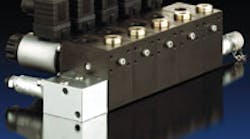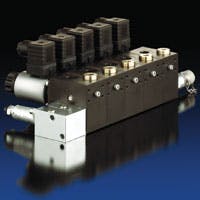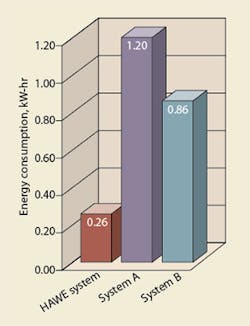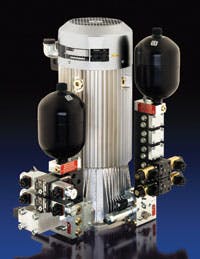Lowering the operating costs and energy demand during production is important for both manufacturers and operators of machine tools. These benefits serve as sales features for machine tool builders and users, who, in turn, can promote to their customers.
Designing efficient hydraulic systems requires not only strategic circuit design, but specifying individual components exhibiting high efficiency as well. For example, officials at HAWE Hydraulics USA, Charlotte, N. C., say that specifying hydraulic power units (HPUs) dedicated to specific circuits can save substantial energy because none is needed when the circuit is not active. This is in contrast to a centralized hydraulic system, where multiple circuits are supplied by a single, large HPU. Recently conducted tests for energy efficiency with three different designs of hydraulic systems.
Energy-efficient components
One method HAWE uses to conserve energy is to mount the HPU’s pump submerged in the hydraulic reservoir. Submerging the motor in the oil provides better cooling for the electric motor, which, in turn, allows using a smaller motor — and a smaller motor uses less power than a larger one.
The smaller reservoir also translates to less oil in the hydraulic system. The compact construction often eliminates the need for a separate installation space for the HPU, so it can be integrated directly into the machine. All pressurized components are made of steel, thereby enabling operating pressures of up to 700 bar (10,153 psi).
Another technique is to use seat type valves. Unlike a sliding spool, a seat valve exhibits positive, leak-free shutoff when the valve is closed. With spool valves, the pump constantly has to re-feed the system during operation to compensate for the inherent leakage around the spool. When used in clamping circuits, clamping pressure is safely maintained even with the pump switched off.
Testing the waters
Recent testing has shown that combining compact HPUs with directional seat-type valves proves to be the most energy-efficient solution for horizontal processing stations.
The test compared three hydraulic systems: System A had a centralized HPU and proportional directional spool valves. System B had a centralized HPU controlled by a variable-speed motor and proportional directional spool valves, and System C had a compact HPU with seat-type directional valves.
The test parameters listed operation at 3600 hr/yr and idle times at 400 hr/yr. The test was intended to identify the power consumption and CO2 emissions. System A required 1.2 kW-hr, System B consumed up 0.86 kW-hr, and System 3, from HAWE required 0.26 kW-hr— a saving of 77% against system A and 68% against system B.
Systems A and B consumed power even during idle periods, with readings of 0.75 kW-hr and 0.4 kW-hr, respectively. The HAWE system, with seat-type directional valves, required no electric power at all when the circuit was at idle.
To ensure consistent operation, machine tools should not undergo wide temperature swings. Therefore, a hydraulic clamping system should be designed as a compact unit with a small reservoir so that it quickly reaches a stable operating temperature. This will cause the pump to only consume power when higher fluid pressure or oil volume is required. Once the clamping pressure has been reached, the seat-type valves will maintain the pressure with zero leakage so the pump can switch off.
Although the savings generated during idle times may seem small, they can add up considerably if the machine operates around the clock. If the seat-type directional valves are fitted with 8-W solenoids, they will not only save additional energy, but also simplify the integration of the hydraulic components to the control technology.
For more information, call (704) 509-1599 or visit www.hawehydraulics.com




